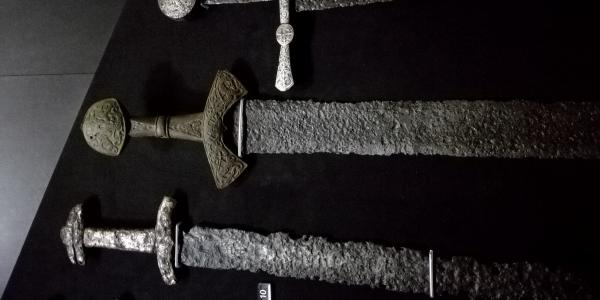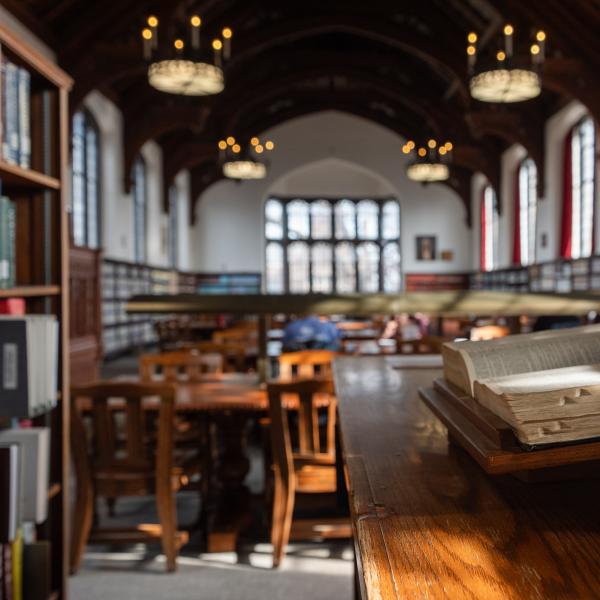The development of materials has always gone hand-in-hand with advances in technology. Metals and glasses have been the dominant materials over the ages; plastics and semiconductors have taken on significant roles in the relatively recent past. Over thousands of years, by trial and error, humankind has learned how to produce superior materials for different types of processing. Physicist Ken Kelton talks about materials through the ages.
Transcript:
Myra Lopez (host): Thanks for listening to Hold That Thought. I’m Myra Lopez. Every era in human history has been defined by materials. Physics professor Ken Kelton is here to tell us how the development of materials has played a crucial role in advances in civilization – and he’ll preview the next big breakthrough in materials science. Here’s a hint. It’s out of this world!
Ken Kelton (guest): My name is Ken Kelton, and I’m a professor of physics and I have a courtesy appointment in mechanical engineering and materials science and I am the Arthur Holly Compton Professor in Arts and Sciences.
KK: Materials science has always been very important for charting epics of civilization. You have the Bronze Age, the Iron Age and so forth, and so it has played a pivotal role in civilization and the development of civilization. So, that has always interested me.
ML: Kelton’s primary focus is the transition of glass – because, he says, the physics are interesting, and he also just plain likes liquids and glasses. In fact, Kelton gives a great lecture titled ‘materials through the ages’ – where he brings some pretty interesting show and tell items.
KK: I have a particular interest, as a hobby that I enjoy collecting swords. You can use swords to explain a lot of the basic processes in materials and that’s why I like it. Why are the swords from the Bronze Age about this long and the swords from the Middle Ages about this long? It’s largely a problem of materials. In the Bronze Age you couldn’t make it very long because it wouldn’t be very useful. It would break or bend. Once we got to steel you could make much longer and stronger swords.
"You can use swords to explain a lot of the basic processes in materials ... Why are the swords from the Bronze Age about this long and the swords from the Middle Ages about this long? It’s largely a problem of materials."
KK: I have three antique swords. So, there is one that is a 15th century merchant sword. That’s the first real sword that I bought. And I think that’s probably kind of what got me into being interested in them. I was on sabbatical in England at the time and I traveled to Edinburgh and I found this, and it was at that time affordable.
ML: His other swords are replicas, English, Scottish, Revolutionary and Naval Swords. In all, he has about eight swords in his collection.
ML: Fast forward to today. What material defines this era? It’s a material with ancient origins that has paved the way for a high-tech future.
KK: Silicate glasses. Glass is a very useful material today. We use it for everything from looking out to holding something in a glass container to fiber optics. All of these sorts of things are glass.
ML: So, suffice it to say we are living in the Glass Age. It’s a technology people use every day on their smartphone, TV, car, home and office. Think about it. It really is the defining material of our time. If we take a bird’s-eye view at materials, can you guess what material in the last 100 years has advanced civilization? If you guessed silicon you’re right.
KK: For all the integrated circuits, transistors, you could have called it the Age of Silicon starting from something like the 1950s on. It was a really dominant material. I don’t know what the new materials are going to be.
"For all the integrated circuits, transistors - you could have called it the Age of Silicon starting from something like the 1950s on."
ML: One thing we do know is that when you advance the materials then you can make big technological leaps. Speaking of leaps… {file audio of Neal Armstrong on the Moon "That's one small step for man, one giant leap for mankind.”}
ML: Those memorable words were spoken by Neil Armstrong upon becoming the first person to land on the moon in 1969. Will we remember the words spoken by the first person to land on Mars? Nearly 50 years after the moon landing, humanity is looking skyward again – this time to Mars. And the goal isn’t just to visit the planet … but to inhabit it long-term. And that means the need to develop lots of new materials. However, Kelton sees lots of challenges.
KK: There are a lot of materials problems with going to Mars. The biggest thing they are working with right know is how do we shield... and maybe it won’t be a material that can do this... how do we shield the astronauts from the radiation? Because once you get outside of our protective cocoon you are getting exposed to solar wind and all sorts of things that are going to be very bad.
ML: And let’s say you successfully get astronauts to Mars - sustaining life there is going to be a challenge. It’s not like you can pop to the store for supplies, you’ll need to make materials in space.
KK: 3D printing. This is a huge area that NASA is investing in. Let’s say you’re out on Mars and something breaks, and you can’t get FedEx to give you the next part, so you have to have a way of making it there and they are looking into 3D printing. And there are a huge number of materials problems there. Again, you are putting things down very quickly generally and the atoms don’t have time to get into the positions that they want to be, and you might have certain crystallization - turning it into other phases that you don’t want. So yeah there is a lot of work to be done there. Yeah, there are a lot of problems to be solved to go to Mars.
"Let’s say you’re out on Mars and something breaks, and you can’t get FedEx to give you the next part. You have to have a way of making it there."
ML: Kelton currently has an experiment on the International Space Station looking at the lack of gravity’s impact on making materials in space, because some of the processes we are accustomed to working with on Earth depend on having gravity.
ML: Growing up in rural Arkansas, not being around scientists, I wondered what sparked Kelton’s interest in science.
KK: My sister bought me a chemistry set because she recognized that, “he needs something to do.” So, she gave me that. And of course, I was born in 1954 and kind of growing up in the whole space age and the nuclear bombs and all this stuff and there was a bigger emphasis on science then there had been before and I kind of got caught up in that.
ML: Kelton hopes to be that inspiration for another child. In addition to giving public lectures, he works with entities on campus - like the Institute for School Partnership - to bring his work into the K-12 classroom. As a child Kelton’s father, a carpenter, took him to tour one of Dow Chemical’s lab spaces, an experience that set Kelton on the path to becoming a scientist. He hopes allowing students to see his work will have a similar effect.
ML: I could not end today’s talk without asking Kelton, what is his favorite material?
KK: Probably metallic glass. Because I did my PhD thesis on metallic glasses many years ago from one of the founders of the field. And then I left it and then I came back. It’s one of my favorite materials. It’s just unique and does what no other material will do.
ML: Many thanks to Ken Kelton for joining Hold That Thought. For many more ideas to explore please be sure to visit our website holdthathought.wustl.edu and subscribe. Thanks for listening.





